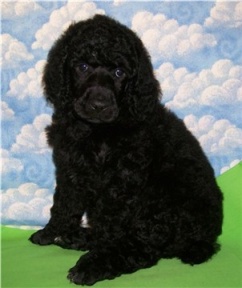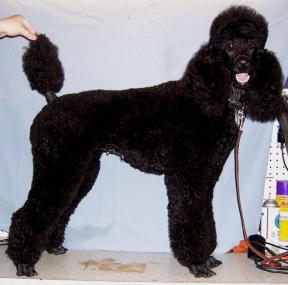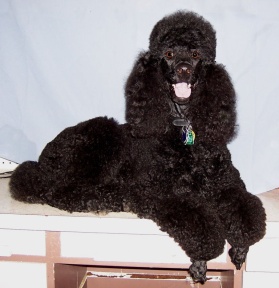|
BLUE VS BLACK
I have also found through the years that many breeders have
no clue what a blue is. Many blues are registered as blacks and as they mature it is realized they are not
blacks. This causes many, many people out there to think that their dogs are bad blacks when infact they are a blue
(this isnt to say that they are no bad blacks). I hope to help show the difference between these colors on this
page. I have collected color articles on poodles and will post them here along with pictures so help show the difference.
The authors of these articles are posted above and below the article. These articles are older but are very good
for defining color and giving you a good idea of how to get that color.
REMEMBER: Many blues are actually born black so unless
you really know what you are looking for you could easily mistake a blue for black.
A blue is NOT a bad black. It is infact a real
color. It is NOT a parti color. You may see some breeders mistakenly refer to these blues as a dog that is a combination
of colors such as grey and black, or brown and black, you may hear them refered to as a phantom when they really are not,
or even hear them called a sable which again they are not.
You can indeed have a blue born blue. When these
puppies are compaired to a black puppy you can actually see they are a blue and not a black.
Blues as puppies will usually have white or silver
colored hair inbetween the pads of the feet. You will also have a brown highlighting of the black hair. This is
one way to tell you have a blue. When taken out into the sunlight or sometimes in the flash of a picture a blue puppy
will almost look dark brown in color. This is almost a sure sign of a blue.
As a blue "clears", which sometimes takes up to 3
years in standard poodles, they will become a dark gun metal grey color.
It has been my experience that blue poodles tend to
carry the genes for all colors of poodles. So for many breeders they are a great asset to a breeding program.
Blues may have black points or self colored points.
*POINTS refers to the color of the nose, lips, eyeliner,
and pads on a poodle.
*SELF COLORED means the same color as the coat
color.
*Because it is usually much easier to
tell the difference between a blue and a black if they are compaired together I will only place a couple pictures of each
individual color below the color articles and will show pictures of blue vs black together at the bottom of the page.*
BLACK COLOR ARTICLES
*Please take into consideration when these articles were written. Some of the
information is a bit outdated and not always what we breed for or believe today.*
BLACK By Mackey J. Irick Jr “The New Poodle”
Black
is the basic, dominant color in Poodles. When a dominant black is mated with any of the other colors, all the puppies will
be black. And as a rule this pure dominant also carries the greatest perfection of type.
A black Poodle's coat should
be absolutely dense and inky jet black. The skin should have a distinct bluish cast. To keep it this way, or to clear it if
it is shaded, is relatively simple. The magic formula is simply to breed jet blacks to jet blacks and never allow the admixture
of any other color. But outside of European countries, where it is obligatory, this is very seldom done consistently. Yet,
without question it is the only way to get and keep inky black, practically unfading coats. A true black has no graying (
or dilution) factor which causes the black to fade with age.
Only one cross is safe-that of black's own dilution,
brown-which, if sparingly used, will not affect the purity of color. But, of course, such brown crosses must be used very
sparingly and not too close together. Some breeders believe that although this cross does not affect the coat color, it may
lighten the color of the eyes. The fact that brown does not affect the purity of black coats is a recognized fact, and even
in countries where the mixing of colors is banned, such a mixture is permitted.
Many
black strains, black-bred for many generations, carry a brown gene which causes browns to appear every now and then in an
otherwise black litter . Such browns usually carry very dark eyes and pigmentation.
Blue, gray and silver crosses
in a black strain are fatal for soundness of color and most difficult to breed out. They leave a most unpleasant grayish shading
in the coat and are crosses that never should be used.
It is not definitely known whether eye color is part of the
same gene for color, or whether it follows a pattern of its own. In countries where black must be bred only to black, the
eyes are very dark, almost black. But nothing has been proven scientifically. Be that as it may, eye color, like any other
point, can be fixed by selection. There is no doubt that light eyes have need of correction in many of our American blacks
as well as in many English imports. A dark, velvety, oval eye plays an important part in the beautiful Poodle expression we
all desire in our dogs. It is too valuable an asset to overlook or to lose carelessly. And in no other color does a light
eye stand out as unpleasantly as in a black Poodle.
Standard and Miniature breeders are still finding it difficult
to create pure non-fading jet black lines, due to the fading factor which appears in almost all American bred lines. The gray
import Ch. Griseley Labory of Piperscroft was a major culprit in Standards as was the gray Ch. Misty Isles Algie of Piperscroft
in Miniature lines. Since the graying gene is a recessive, it is particularly difficult to cope with in breeding. Two apparently
good blacks may harbor the graying gene and when bred together will produce a proportion of blacks who will gray as they age.
Breeders have a better chance of stabilizing and enhancing a good black by using an older male who has held his color
until nine or ten years of age. Breeding to an excellent colored young dog who grays in later years is another problem. Even
worse is discovering you have used a beautiful colored jet black who has been dyed!
A male's true color may best be
observed at home in his later years rather than in his glamorous show ring days. Unfortunately, almost all blacks fade to
some degree and a true jet black at ten years is still a rarity. It has been observed that some of the best lasting blacks
only gray around the muzzle rather than a gradual and steady all over graying with age.
BLACK
By Mackey J. Irick Jr “The New Poodle”
_______________________________________________________
BLACK By Mrs Hoyt - The Book of the Poodle 1982
A
deep intense glowing black that in the sun gives off an almost metallic blue-black tone. Eyes very dark, not necessarily as
black as those of a white, but so dark as to be described as a "black brown," not just brown. Eyerims, lips, nose, and toenails
black.
Common Faults: Such dogs may have a few silvery or white hairs throughout the coat. Pro- vided that
they are not so numerous as to cause streaks or spots this is no fault.
Such dogs may have a white spot on the chest.
This is a show fault, provided it is noticeable, but no breeding fault.
Such dogs may have a brownish or rusty tinge
on the top of the coat. This is a show fault, and the breeder must look into the animal's background. Is this tinge caused
by weather, or an unhealthy coat, or is the color always like this? In other words, a poor black? This fault can be eliminated
in the offspring by proper breeding.
Such dogs may have a grayish tinge about the muzzle or ears. This can be old
age. It is a show fault but need not worry the breeder. If the dog has gray blotches or the coat is rust-colored down to the
skin, it is a bad black and should not be used.
Such dogs may have a truly brown eye rather than the very dark brown.
This is a minor fault, not much penalized in the ring, but the breeder may wonder how much mixed color is behind such a dog.
Question: Will breeding blacks to browns hurt the black?
Answer: The black will not be hurt
if only one brown cross is made. If, however, a second brown cross is made into the black line, light eyes may be the result.
Question:
Will breeding black to white im- prove the black coat?
Answer: It may, but why not breed to a good- coated
black from a line of good-coated blacks? Most blacks are more refined in type than the whites. Why risk hurting your type
when there ARE good-coated blacks, not to mention mixing up the color heritage.
Question: Will breeding to
a gray improve an open black coat?
Answer: It may. It is better breeding than to a white or a brown. It would
be best to select a gray related to your bitch on the gray's black side. Here is an example: Champion Blakeen Roulette of
Misty Isles was a black Standard female with excellent type, good temperament, good quality coat, but a decided tinge of brown.
Roulette's sire, Nymphaea Pice, was a black of only fair type with a large white splash on his chest. He could not be shown.
Pice came from a mixed heritage of brown, black, and white. His dam, Ranee, was a brown of better type than Pice, but had
a very poor temperament, timid, high-strung, etc. Roulette's dam, Anita v Lut- terspring, was a black of excellent type and
temperament, German bred. Roulette bred to Champion Harpendale Monty, an English black of fair type, and produced an all-black
litter, no brown tinge, fair type, and excellent tempera- ment. Monty had a most aggressive tempera- ment, which was inherited.
Roulette bred to Eric Labory, who went back to German breeding as did Anita and was a black of excellent type and coat but
had a very poor, timid temperament, produced all-black puppies with excellent coat and type. Two became champions. They were
not as timid as Eric, but not perfect in tempera- ment. Roulette bred to Champion Griseley Labory of Piperscroft of Blakeen,
C.D., (an im- ported Swiss gray nephew of Eric on his sire's side) produced coal-black puppies. These pup- pies were even
blacker than the Eric puppies and had excellent coats and perfect temperaments. The one I kept (I did not keep any from her
other litters) became a well-known winner and stud, champion Blakeen Mirandello. He won Best Brace in Show with his kennel mate Cham- pion
Blakeen Michael Mont at Westminster one year. He never sired a brown or a gray, and his black offspring were very black.
This
last had been the right mating for Roulette. If Griseley had been a black, it might have been even better. When Roulette
was bred to brown she produced some browns. Bred to Duc (white Tri-International Champion Nunsoe Duc de la Terrace of Blakeen)
she produced an excellent brown bitch with a white chest. This bitch bred to blacks produced blacks and often one or two browns.
Question: Is black a popular color in the show ring and with the public?
Answer: In the show
ring, next to white, it is the most popular. It is difficult, however, for a good black to defeat an equally good white, as
good whites are very appealing and glamorous. With the public it is the most popular color of all. Black puppies are the easiest
to sell. Black is therefore the easiest color to breed successfully as to money as well as type. A clue to black breeding:
remember the most glamorous thing about a black, besides good type and tempera- ment, is blackness.
BLACK By Mrs Hoyt - The Book of the Poodle 1982
___________________________________________________________
BLACK - from
an article by Pamela Ingram, Sassafrass Kennels
I do not want to write about the blacks at all. You might say, "black
is black" and, like all breeders, I adore the black poodles.
They are stylish,intelligent and handsome. They are hard
to beat in the show ring---mainly,I suspect, from the
fact that faults, being so dark, do not show up so much.
However, it is a difficult color to breed if a black is accepted as
being a true holding jet black color! I know of some
lines, especially in the toys, which are certainly blackish
at one year of age, and most certainly fadedand most
unattractive by two and a half to three years. What value is there to
having ten generations of black breeding only to have them deteriorate,as it were, in the prime of life?
A true black has no fading factor. A true black does not fade in the
sun.
A true black is a black minus white hairs in the 5th, 7th, and 9th
yrs, allowing only for some graying on the muzzle.
How many have you ever seen? Granted, black is dominant as a colorbut, like any other dominant ( whether the stronger sex or not ) it appearsto have hidden weaknesses.
I have seen jet blacks non--fading from blues, jet blacks non--fading
from brindled apricots, jet blacks non--fading from white
and brown and last butnot least jet blacks non--fading
from jet blacks. The whole secret is thenon--fading or
lack of dilution factor. Black is not just DARK, it is BLACK, shiny,
sooty, boot black black---no white hairs ---no brownish tinge---justblack, so black it is JET black.
In lien of color when whelped, at six weeks, six months, etc., I would
prefer to start backwards: What color are the parents
at six yrs, three yrs.,one year? If a black aged one
has as many as 20 white hairs in the coat,it is going
to turn gray early and go on graying month after month, yearafter
year. Keep the blacks that stay black and breed from them---use an older
black stud in place of the young "dark" ones and then we'll get blacker
than blacks that stay that way.
from an article by Pamela Ingram, Sassafrass Kennels
| Black standard pup at 6 weeks |

|
| Black adult |

|
| Chewy owned by Mike M. |
| Black standard adult |

|
| Chewy owned by Mike M. |
|